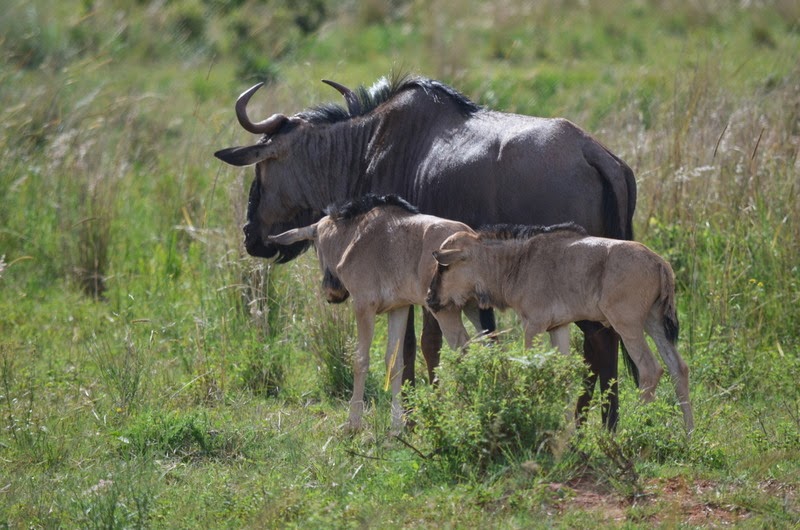I’ve never been much into birdwatching, but my time here is
changing that, thanks to the many beautiful birds that Rishi and I have seen during
our travels in Botswana and South Africa, as well as right here in Gaborone.
When I return home, birdwatching may come along as a new hobby.
To understand the richness of birdlife here, consider that
the Southern African region (area south of the Zambezi and Kunene rivers
and encompassing South Africa, Lesotho, Swaziland, Namibia, Botswana, Zimbabwe
and part of Mozambique, plus offshore waters within 200 nautical miles) has a
species list greater than 900 species. By way of comparison, the American
Birding Association species list for the 49 continental US states and Canada
contains 987 species, but in an area about five times larger.
Without further ado, the photos below highlight some of the
birds we’ve seen.
.JPG) |
| Lilac Breasted Roller -- the national bird of Botswana, but commonly seen throughout the region. Madikwe Game Reserve, South Africa, August 2014. |
I took the video and the next four photos below at Motswiri Private Safari Lodge in Madikwe Game Reserve. The day was blazingly hot, so in between our morning and evening game drives, I spent the midday hours alternately dipping in the pool, reading in the shade under the poolside umbrellas, and watching birds. Several Southern Masked Weavers, so called because of the nests they literally weave from bits of grasses and twigs, were nesting in the tree next to the pool. These beautiful yellow and black birds are an everyday sight in Gaborone, but at Motswiri I was able to get very close to them. The video quality isn't great, but shows what the nests look like (sorry friends, this requires flash, so it won't display on an Ipad or some tablets).
Southern Masked Weaver video, Motswiri Private Safari Lodge,
Madikwe Game Reserve, South Africa, February 2015.
 |
Southern Masked Weaver. Motswiri Private Safari Lodge, Madikwe Game Reserve,
South Africa, February, 2015. |
 |
| Blue Waxbill, just like me, using the pool to cool themselves on such a hot day. Motswiri Private Safari Lodge, Madikwe Game Reserve, South Africa, February 2015. |
 |
Cape Glossy Starling. Poolside at Motswiri Private Safari Lodge,
Madikwe Game Reserve, South Africa, February 2015. |
 |
| Grey Lourie, popularly know as the Grey Go Away because of its ka-waaaay call. Motswiri Private Safari Lodge, Madikwe Game Reserve, South Africa, February 2015. |
 |
| European Bee-eater. Madikwe Game Reserve, South Africa, February 2015. |
 |
Red-billed Oxpecker, foraging for parasites on a Cape Buffalo.
Sabi Sand Game Reserve, South Africa, January 2015. |

 |
Egyptian Geese. Kirstenbosch National Botanical Garden,
Cape Town, South Africa, September 2014. |
 |
Helmeted Guineafowl (top) and Cape Francolin (bottom) -- two studies in feather patterns.
Both are frequently seen in the bush, but these photos are from Kirstenbosch National Botanical Garden, Cape Town, South Africa, September 2014. |
 |
| Yellow Hornbill. Entabeni Nature Conservancy, South Africa, January 2015. |
 |
Giant Kingfisher, perched underneath Kingfisher Lodge (where else?),
Entabeni Safari Conservancy, South Africa, January 2015. |
 |
| Ostrich. Entabeni Safari Conservancy, Limpopo, South Africa, January 2015. |
-001.JPG) |
| Saddlebilled Stork, standing in the Sand River. Sabi Sand Reserve, South Africa, January 2015. |
 |
Jackass Penguin and chick.
Betty’s Bay,Western Cape, South Africa, September 2014. |
 |
Jackass Penguins. Betty’s Bay,
Western Cape, South Africa, September 2014. |
Sources:
Sinclair, Hockey, and Tarboton, Sasol Birds of Southern Africa, second Edition, Struick Publishers,
Cape Town, 1998.























.JPG)













-001.JPG)







.JPG)
